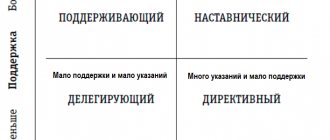Psychological climate is the mood of the team, the moral and psychological atmosphere that permeates the relationships of its participants. We are not necessarily talking about the work collective, although more often this is the case. The psychological climate exists in an interest group, in the family, in school, and in any collective activity. The success of this activity and the health of each of its participants depend on the atmosphere prevailing in the group. Creating a favorable psychological climate is included in measures to prevent psychosomatic diseases, conflicts, and neuroses.
What it is
The term “psychological climate” was first uttered by N. S. Mansurov in the context of studying a production team. A little later, psychologists began to distinguish between socio-psychological and moral-psychological climate. Psychological climate is a broad concept, the rest are included in it.
Psychological climate is the nature of emotions that arise in relationships between people, based on their sympathies, coincidence of interests, characters and inclinations. The psychological climate includes 3 areas:
- Social climate – awareness of goals and objectives by all participants, respect for rights and responsibilities.
- Moral climate - values accepted in the group. Their unity, acceptance, consistency.
- The actual psychological climate is informal relationships in the team.
There are 4 approaches to studying the psychological climate in a team:
- Climate is a collective consciousness. Awareness by each member of society of relationships in the team, working conditions, methods of stimulating it.
- Climate is the mood of the team. That is, the leading role is given not to consciousness, but to emotions.
- Climate is the style of interaction between people that influences their condition.
- Climate is an indicator of the compatibility of the group, the moral and psychological unity of its participants. The presence of common opinions, traditions and customs.
The peculiarity of the psychological climate as a phenomenon is that it is created by the person himself, he is able to influence the climate, improve and change.
Features of communications
The atmosphere of a team is always based on the personal characteristics of each of its members.
It is important to have communication skills, the characteristics of their assessments, opinions, and social experience. For example, the difficulties that some group members experience in communication can affect the situation in the team as a whole.
For this reason, tension, mistrust may increase, disputes and conflict situations may arise. If each member of the team is able to clearly and accurately express their point of view, properly masters the techniques of constructive criticism, and has active listening skills, then this helps to create a favorable psychological climate in the group.
When analyzing the characteristics of the psychological compatibility of each member of the team, it is necessary to take into account such a factor as the type of communicative behavior. This classification was first developed by V. M. Shepel and includes the following categories:
- Collectivists are sociable people who will always support any initiative. If necessary, they are capable of taking the initiative.
- Individualists. Those employees who prefer to work alone rather than interact as part of a team. They are much more inclined towards personal responsibility.
- Pretenders. As a rule, such employees are often called vain, touchy, and eager to be the center of attention while working. And such a characterization is not without foundation.
- Copycats. People who seek to avoid complications, and for this purpose imitate other people's behavioral manners.
- Opportunists. Weak-willed team members who rarely take initiative and fall under the influence of others.
- Isolated. People who avoid contact. They often have a completely intolerable character.
Favorable and unfavorable climate
The psychological climate can be favorable or unfavorable. The first is characterized by:
- friendly attitude of participants towards each other;
- camaraderie;
- adequate mutual exactingness, which determines creative and effective activity;
- mutual assistance;
- joy from communication and openness of communications;
- safety and comfort;
- optimism;
- self-confidence and team confidence;
- the opportunity to think freely and creatively, to discover and realize one’s own potential.
But it is worth noting that a combination of mutual demands and mutual assistance is mandatory. Mutual assistance alone will turn into permissiveness, a “brotherly” attitude, which over time will create an unfavorable climate.
An unfavorable or unhealthy climate includes the opposite characteristics:
- pessimism;
- mistrust and disrespect;
- coldness and secrecy in relationships;
- inhibition of personal potential;
- irritability;
- tension and conflict;
- uncertainty;
- misunderstanding;
- fear of error, punishment and rejection;
- suspicion.
It has been noted that a healthy climate increases productivity and labor efficiency. Unfavorable climate causes frequent incidents of safety violations and reduces productivity by 20%.
A healthy climate satisfies the needs of its members and does not conflict with social norms and values. For example, in a criminal group there may be a unity of opinions, views and beliefs, but for society the activities of its members are harmful, in fact, as in the end for the participants themselves (they just don’t know it).
Climate levels
Climate has two levels: static and dynamic.
Static
This is a stable attitude of employees towards work, constant interpersonal relationships. The climate is stable and tolerates external influences well. It is not easy to create a climate at this level, but then it is easy to maintain. Team members feel this stability, which makes them more confident in their own position. Climate correction is practically not required, control is occasional. This level is also called the socio-psychological climate.
Dynamic
This is the changing nature of the team. The climate changes daily due to the changing moods of its participants. This level is also called the psychological atmosphere. It changes faster and is less felt by the participants. As changes accumulate, it can create an unhealthy climate in the team.
We are constantly monitoring the situation
The climate within the same team changes over time. This may be due to the external environment - for example, during a crisis, all relationships become strained, much more effort is required from the team, and fear of dismissal arises.
The situation within the team can also change, since the emotional background directly depends both on the leader, who may have different periods in his life, and on the team members, whose life situation, emotional background, roles and positions, goals and priorities may also change. .
Climate diagnostics
The socio-psychological climate in a team is an indicator of the level of development of the team. Therefore, it is important to regularly carry out diagnostics and monitor dynamics, to identify the properties that hold the team together or destroy it. For this purpose, the method of assessing the level of psychological climate of A. N. Lutoshkin’s team is suitable.
The subject is asked to answer 13 statements regarding the team in which he is located. The score can be from -3 to 3.
Answer form
22 points and more – highly favorable climate.
8-22 points – moderately favorable climate.
0-8 points – low favorable climate.
From 0 to -8 – initial unfavorability.
From -8 to -10 – moderately unfavorable climate.
From -10 and more – pronounced unfavorability, unhealthy climate.
Each team member takes the questionnaire. When summing up, all points are summed up and divided by the number of people surveyed. The final number is the overall score of the team. You can also calculate an overall score for individual criteria.
Looking for the weak link
Another factor that affects the team climate is an employee who is toxic to the team. I have a client - a large pharmaceutical company, in whose marketing department one of the employees was critical of the manager and practically created an opposition group against him.
As a result, employees, instead of working to achieve ambitious goals for promoting new drugs to the market, spent their time and energy on endless discussions and gossip. In such a situation, the only possible solution was to fire the destructive employee.
Test: find out if you can competently enter the market in another country
Another example. In a large manufacturing company, at a certain moment, the plant director entered into a state of conflict with almost all related departments; the company management understood that a difficult and stressful climate had developed, but they were in no hurry to part with the director due to the fact that his qualifications were unique in the industry.
As a result, the shareholders talked with the director of the plant, tried to get the most open feedback, and it became clear that the conflict situation and difficult climate arose due to the fact that the director felt personally responsible for the commissioning of the new line, but was faced with a large number of problems related to failure to meet deadlines and promises from other departments and external contractors, and in connection with this he panicked, became stressed and lashed out at his employees.
They hired an experienced deputy, helped him with planning and gave him more authority, after which the situation leveled out and the climate in the team became much more friendly.
Signs characterizing climate
Externally, you can judge the climate of a team by the following signs (useful for those applying for a job):
- staff turnover;
- product quality;
- level of discipline;
- claims and complaints, negative feedback from employees;
- frequent breaks from work;
- negligence and carelessness.
The better these indicators, the more favorable the climate. Signs of a favorable climate also include:
- trust and high demands in relationships;
- kind and constructive criticism;
- freedom of speech and opinion;
- providing initiative to employees, lack of managerial pressure;
- awareness of participants in team issues;
- satisfaction from belonging to this group;
- mutual assistance and highly developed empathy;
- responsibility for yourself and the entire team.
Democratic style
This type of management is based on very trusting and friendly relationships between all team members, as well as goodwill and sociability. In this case, all responsibilities, powers and initiatives are distributed between the manager, his deputies and subordinates. All decisions are made collectively.
The director, who has adopted a democratic management style as a basis, cares about the opinion of his subordinate team regarding key production issues. Communication between the manager and employees occurs exclusively in the form of wishes, requests, advice and recommendations.
Rewards for quickly and efficiently completed work are not excluded. Communication takes place in a polite and friendly manner. If necessary, orders are used (extremely rarely).
What affects climate
The climate is influenced by a number of factors:
- Type of organization, team. Open or closed, private or public, scientific or industrial organization. Family, class, criminal group, charitable association.
- The image and standard of living of the team members.
- Micro (everyday for a particular person) and macro (city, country, culture of society) conditions: normal, complicated, extreme.
- Rational organization of work, compliance with the regime and rights, taking into account the capabilities and characteristics of each team member.
- Team structure.
- Informal leaders or groups in a team.
- Leadership style and features. A favorable climate requires attention from the manager not only to production issues, but also to the personal problems of team members. That is, the democratic style.
- Individual psychological and personal characteristics of team members. Personal opinion, mood and behavior of a person contribute to the overall climate. This is based on passing external factors and events through the prism of one’s own character and personality.
- The combination of the characteristics of all participants forms a new collective quality - the psyche of the collective. Therefore, the psychological compatibility of the participants, primarily in terms of temperament, plays a big role. Psychologically, people must be compatible in terms of psychomotor reactions, emotional and volitional manifestations, the work of thinking and attention, and character. Incompatibility causes antipathy, hostility, and conflicts.
- Self-assessment of each participant. His self-awareness and the correspondence of claims and achievements.
The leader has a great influence on climate formation. You should pay attention to his personal qualities, attitude towards other participants, authority, leadership style. A positive climate is created by a leader who:
- principled;
- responsible;
- active;
- disciplined;
- kind, responsive and sociable;
- has organizational skills.
Rudeness, selfishness, inconsistency, disrespect, and careerism have a negative impact on the health of the climate.
The conditions that dictate the climate also depend on the leader. Necessary:
- be friendly and respectful in relationships;
- provide employees with the opportunity to choose their own area of activity;
- notice and celebrate the activity and creativity of employees;
- promote employee interest in self-development;
- motivate employees for career advancement with the aim of not only material gain, but also to gain prestige and recognition from the team;
- be a good qualified leader and a kind mentor.
What a leader can do for a favorable climate:
- It is justified from a psychological standpoint to select personnel.
- Organize regular training and certification.
- Study and practice the theory of psychological compatibility, that is, have a good understanding of people.
- Contribute through practical activities (through organizing events) to the development of interaction and relationship skills.
Basic strategies for managing social tension in a team
Currently, there are many strategies for creating a favorable socio-psychological climate, that is, reducing social tension. They provide for the following activities:
- When recruiting a work team, it is necessary to take into account the psychological compatibility of employees. Depending on the goals, it is necessary to combine different types of human behavior. In many situations, a group with representatives of the same character will turn out to be of little efficiency, for example, if only employees who are waiting for instructions and do not know how to take initiative, or only those who like to command, gather together;
- Optimal selection, placement, training and periodic certification of management personnel;
- Acceptable limitation on the number of employees subordinate to one manager (5-7 people);
- No extra workers or vacancies. Both a lack and an excess of team members lead to its instability. There is room for tension and conflict to arise due to the desire of several candidates to take a position and receive promotion, or due to the resulting unevenness of workload due to the presence of “extra hands”;
- Reliance in work on the most authoritative, active members of the team (informal leaders) who enjoy the trust of the staff;
- Managing the process of forming meaningful psychological components of climate (norms, expectations, values, attitudes, group opinion and mood);
- Prevention and resolution of interpersonal conflicts;
- The use of socio-psychological methods that contribute to the development of effective mutual understanding and interaction among team members (employees’ passion for personal example, the use of socio-psychological trainings, business games, persuasion methods, etc.).
Psychologists have developed many social and psychological methods for creating a good climate in a team. These include:
1. Body psychotherapy. It is based on the recognition of the close connection between mental and physiological processes, in particular on the fact that personal characteristics are manifested in postures, gestures, and movements. In management, bodily psychotherapy is used in organizing psychological relief rooms at enterprises, booths with mannequins for managers (to release negative emotions, etc.).
2. Art therapy. This technique is based on the fact that a person’s inner “I” is reflected in visual images every time he draws, paints a picture, or sculpts a sculpture, without thinking about his works (that is, spontaneously). The materials obtained during work with the group make it possible to identify the degree of aggressiveness and other negative feelings in people, help resolve conflicts and improve relationships between participants. Art therapy is used in the fields of social rehabilitation and occupational therapy.
3. “Skills training” groups. They belong to the behaviorist direction in psychology. The approach to work is based on a training model, goal setting, measurement and assessment of behavior. An example would be “self-confidence training” groups. In this way, they teach the ability to plan a career and make decisions, develop the ability to cope with anxiety and improve communication skills.
There are also many other methods and trainings aimed at creating a favorable emotional climate. Currently, some enterprises employ full-time psychologists. They organize psychological games, tests, and work with staff. Some companies invite outside specialists for a while. This, of course, has a beneficial effect on the socio-psychological climate.
Creating a favorable climate
A favorable climate is formed where participants clearly see the goals of the team, clearly understand and accept them. At the same time, they have a flexible system of means and ways to achieve them.
The higher the level of development of the team, the more favorable the climate. However, even at a low level of development, a favorable climate can be created.
It is important to maintain the unity of motives, interests, beliefs, ideals, attitudes, needs of the participants and correctly combine their individual characteristics.
A favorable psychological climate cannot arise by itself. This is the product of the coordinated and hard work of the entire team, and the competent organizational activities of the leader.
Purposeful work must be carried out to create a favorable climate. This is a responsible and creative undertaking that requires knowledge of human psychology, the ability to predict likely situations in relationships, and understand emotions and their regulation.
Creating climate begins with changes in each individual person. In order for interpersonal relationships to develop favorably, you need to:
- work on your own negative character traits;
- to form positive moral qualities (respect for people, recognition of their dignity and honor, attention, recognition of the beliefs and interests of other people, trust, observance of politeness and rules of behavior, objective assessment and self-esteem, tact);
- use polite words and phrases, observe etiquette;
- master methods of emotional and mental self-regulation (necessary for the prevention and elimination of irritation, resentment, burnout, nervousness, anger, fatigue, agitation, apathy);
- know strategies for behavior in conflict situations and be able to resolve them competently;
- avoid maximalism in judgment and behavior, egocentrism, labeling, categoricalness, inflated expectations and ideas.
Each member of the team should be valuable, unique and positive in their own way, and in a group setting they should complement each other, not interfere or overshadow each other.
Satisfaction as a criterion
The basis for climate assessment is people’s satisfaction/dissatisfaction with relationships in the team and the activity itself. However, you need to understand that satisfaction can be subjective and objective.
It often happens that one person is completely satisfied with the team, while another is not at all satisfied with the working conditions. This is subjectivity in assessment. Differences in experience, conditions and quality of life, interests, character of people and other individual characteristics contribute. The principle of subjective satisfaction is the relationship between the parameters “I give” and “I receive”.
Dissatisfaction with delayed wages, regular punishments, non-compliance with labor standards, violation of rights is an objective indicator.
Holy cow (or just a good person)
Everyone knows that a good person is not a profession. However, in almost every large organization there are people who do not perform any special functions, except that they are somehow dear to management. These are not necessarily attached relatives. More often there are “veterans” who did a lot of useful things for the company... about 20 years ago. And the leaders simply do not have the courage to part with them.
Why are they dangerous?
In communication, “sacred cows” can be anything - depending on your luck. But they clearly cannot cope with their daily responsibilities. This means that others regularly have to do their work, as well as clean up the consequences of their mistakes. Their idleness often demoralizes the team, because what’s the point of trying “for that guy”?
How to neutralize. No matter how righteous anger torments you, it is unlikely that you will be able to get rid of this colleague (since no one has succeeded in this over the previous 20 years). Direct confrontation will hurt you, not him. Most likely, you will have to come to terms with this state of affairs and try not to end up with the “sacred cow” on the same team.
Read also: Chokeberry sauce for the winter
Afterword
Psychological climate is sometimes identified with socio-psychological or moral-psychological, which further emphasizes its basis. The basis of a favorable climate is the unity and similarity of values among team members.
The nature of the climate affects the individual: whether or not it stimulates work, joint activities, raises or lowers the mood, instills faith or self-doubt in one’s own strength, cheerfulness or despondency, stimulates or suppresses activity.
It is very easy to guess the nature of the climate. It is enough for its participants to only answer the questions “like - don’t like”, “satisfied - doesn’t suit”, “would like - don’t want to be in a team.”
Learn about what the psychological climate in a team is and how to create a favorable climate from the specialists of the Synergy University of Self-Development.
Features of the working atmosphere among teachers
Special attention should be paid to the issues of psychological climate in the teaching staff. This area is always stressful, and the working atmosphere is often one of the factors that determines the effectiveness of a teacher.
The unity of the teaching staff always occurs within the framework of performing some common task or activity - first of all, social, pedagogical. In such events, each teacher should have the opportunity to realize their creative abilities.
Of course, holding methodological days or creative meetings of teachers often requires additional time, but such events remain in the memory of teachers for a long time as bright and unforgettable events.











